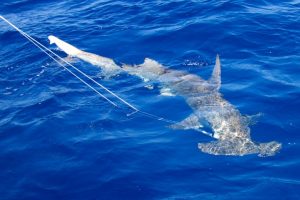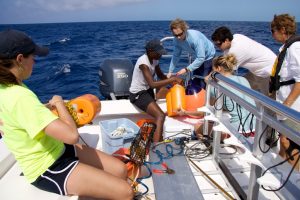A great start to a sharky weekend!
June 4th, 2010
Although I did not begin the day to a cheerful – birds chirping – kind of note (as it was 5:45 am and the birds were still sleeping), once I hopped on the Turnpike headed south, saw the crimson sun burst out from behind the cloud-packed horizon, I knew today was going to be a day to remember. As it was my first boat trip with the Dunlap crew, all was new and all was unfamiliar. The tiny dive boat that we launched from the Keys Marine Lab dock appeared as if we had carefully booby-trapped the deck. From buckets of giant barbed hooks to miles of heavy-duty fishing lines and ropes, you definitely had to be careful where you stepped.
Cruising out to the wreck, the skies began to open up, revealing a glistening sapphire blue ocean below. Once again, the Keys pull through with a range of visibility most divers only dream about. Of course as a diver myself, I couldn’t decide what kind of dream it was, since I would be jumping in shark-baited water to ease my sea-sick stomach.
With the first couple lines we heaved upward out of the water, our luck began. Number one: a male Dusky, at a total length of 195 cm. His left eye, however, seemed to be damaged to the point of possible blindness. As we would discover throughout the day, almost every shark we pulled out of the water would have their own scars and wounds that told unique stories of battle. Luckily, we were premiering our hook-timers that day, which allowed us to see how long the sharks had been hooked prior to being pulled on-board.

Dr. Hammerschlag is testing our pop timers, so we can see how long the sharks have been on the line. (click to enlarge)
Over the following few hours, we pulled in all ten lines, studying and tagging the sharks hooked on the end and re-baited them for one more go. The first round turned up three Blacktips, all male, ranging in length from 151 to 159 cm. By the end of the day we also had 4 large female Sandbar sharks, ranging from 212 to 221 cm. These ladies were all determined to put up a fight, too. While attempting to heave the first shark onto the boat, Neil lost his holding and splashed into the deep blue alongside our shark (although he claims it was just to double check its species identification from a new angle).

Dr. Hammerschlag decides to take a dip in the ocean to double check species identification, haha. (click to enlarge)
The final two sharks were, in my opinion, the most exciting. On line number 9, we hooked a baby Tiger shark, a female with a length of 188 cm. She was so young her stripes had not even joined together, remaining spotted. And for the grand finale, a male Great Hammerhead at a whopping length of 277 cm. Once on-board, we attached a satellite tag to track his path. After a bit of debate, he was donned the name “Chad.” All in all, a great day! Ten sharks and very tuckered-out crew members…

A beautiful Great Hammerhead swimming towards the boat to receive his new satellite tag. (click to enlarge)
Thank you to everyone involved, it was a fantastic trip. See you soon!
Yours,
Christine Shepard (Shark Intern)






There were some awesome pictures from this trip! I just looked through them and wow, I haven’t seen a black tip in a while. Also, beautiful hamerhead! Looks like it was a great trip.
Thanks for showing me how to send a comment about your blog site. You’re a good teacher. I especially liked the one of a HAMMERHEAD!!! swimming in the Gulf of Mexico when we were on the research boat! Thanks for all you are doing to help save the sharks and for helping our environment get better. I love you. Grandpa
Great photos of the sharks. It is good to see more active measures are being taken to monitor their life history. It is imprtant that they have adequate protection, like all other fish, so they are not hunted to extinction. Good luck with your research.
thanks for posting those nice picture of creation of sea,its really lovely in the eyes.